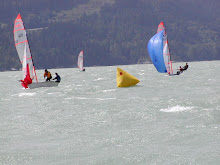I would encourage everyone to learn how to splice modern 12-strand ropes such as dyneema or vectran. It's easy to do and only requires a needle, thread, and some bendy wire for a fid.
Sites like samsonrope.com have free splicing instructions.
Ok for the vang, without an actual "vang fitting" I had to go back to the mainsheet for a point to secure.

The thing loops through the fitting and around the boom.

Travels down the boom...

Then it loops around the boom again. I had to measure a bit to get the length right, because of the angle caused by the vang itsself.


Then a little Karver block for coolness. Who said old boats can't be hip?


This weekend I paint the boat. I might not be able to resist sanding it ten more times. All that old gel-kote is just weight, plus who doesn't like to get sweaty and covered in dust for a few hours?? Ahhh



















































